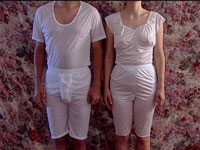 Welcome to a new series of columns on the Church of Jesus Christ of Latter Day Saints for people who are unfamiliar with the Mormon Church. Since Mitt Romney is a viable candidate for president, the religion is being discussed a lot. I, personally, had not heard much about the church before I moved to Colorado. The church is based in Utah and is much more common out west. Since moving here, I’ve had the opportunity to learn more about the church and thought I’d share some facts. NurseWretched pitched in with her extensive knowledge of the church as a one-time member.
Welcome to a new series of columns on the Church of Jesus Christ of Latter Day Saints for people who are unfamiliar with the Mormon Church. Since Mitt Romney is a viable candidate for president, the religion is being discussed a lot. I, personally, had not heard much about the church before I moved to Colorado. The church is based in Utah and is much more common out west. Since moving here, I’ve had the opportunity to learn more about the church and thought I’d share some facts. NurseWretched pitched in with her extensive knowledge of the church as a one-time member.
There can be no discussion about the Mormon Church without a discussion of Mormon underwear. This was one of the first things I heard about the church. “Did you know they wear magic underwear?” I thought I’d address this issue first since it generates so much curiosity.
The “underwear” are actually properly referred to as Temple Garments. Members receive these garments after they have taken part in an Endowment Ceremony, which is sort of a formal initiation into the church. Most members take part in this ceremony either before they embark on a mission or before a temple marriage ceremony. The Endowment Ceremony is a sort of formal commitment to the church, sort of like a Catholic Confirmation.
The temple garment is given to a member during the washing and anointing segment of the Temple ceremony. These garments are considered to be sacred and aren’t shown publicly. The garments provide protection from the evils of the world. The protection is symbolic for some people and literal for others. Church members don’t take these garments lightly and generally don’t care for the jokes that people make about them. They consider these as serious as their commitment and relationship to their savior.
 The garments standard color is white. Originally, the garments had markings snipped into them but now these markings are embroidered with Masonic symbols. Joseph Smith, the founder of the church, was inducted into the Freemasons shortly before he created the church’s original Endowment Ceremony. There is a reverse L-shaped symbol on right breast, called “The Square” by early church leaders. It represents justness and fairness of the Heavenly Father. The V-shaped symbol on the right breast is called “The Compasses”, which represent “the North Star.” There is a horizontal mark at the navel that represents “strength in the navel and marrow in the bones”; and a horizontal mark over the right knee that represents “that every knee shall bow and every tongue confess that Jesus is the Christ.”
The garments standard color is white. Originally, the garments had markings snipped into them but now these markings are embroidered with Masonic symbols. Joseph Smith, the founder of the church, was inducted into the Freemasons shortly before he created the church’s original Endowment Ceremony. There is a reverse L-shaped symbol on right breast, called “The Square” by early church leaders. It represents justness and fairness of the Heavenly Father. The V-shaped symbol on the right breast is called “The Compasses”, which represent “the North Star.” There is a horizontal mark at the navel that represents “strength in the navel and marrow in the bones”; and a horizontal mark over the right knee that represents “that every knee shall bow and every tongue confess that Jesus is the Christ.”
The garments have undergone some changes since they were first created. The original versions were one piece and went all the way to the ankles and wrists. Two-piece garments were introduced in 1979 to much controversy among the faithful. Today, they are t-shirt styled for men and cap-sleeved with a sweetheart neckline for women. The bottoms are shorts which end just above the knee. They encourage modest dress. The scoop neck of the men’s garment is fairly distinctive and can be seen under most clothes. It’s often referred to as the “celestial smile.” The faithful do notice if others are wearing the garments or not and make character judgments accordingly.
Members are encouraged to wear the garments constantly and should not alter them. They can remove them for things like swimming, showering and naughtiness (within the confines of matrimony), but are supposed to put them back on immediately afterwards. Women are supposed to wear their bras over the garments although there are rumors that some women rebel. There are special garments with holes for breastfeeding and the nursing bra goes on over the garments.
One of my first questions to NurseWretched was “What the heck do women do when Aunt Flo comes to visit?” I was concerned that leakage could result in at least a shunning or possibly ex-communication. Her answer was “The pad goes on the inside of the garments, and you can put a pair of normal panties over the garments to make it snug.” There are no records of excommunication for menstruation, which I found reassuring.
The garments are treated with reverence, much like the flag. Members never fling them carelessly on the ground like heathens often do with their underwear. They often wash them separately from their other laundry. Some people even handwash them. When garments have reached the end of their natural life, the owner is supposed to cut off the symbolic markings destroy them so they aren’t recognizable. Then, the remaining cloth can go the route of old underwear everywhere – dustcloths.